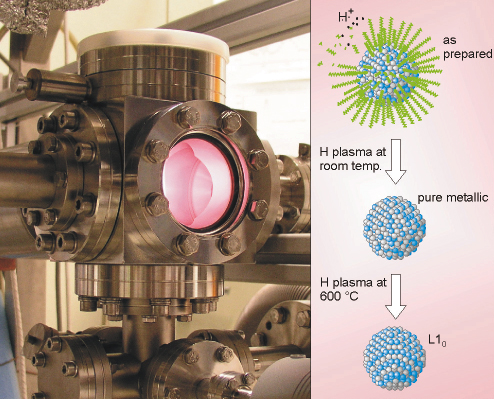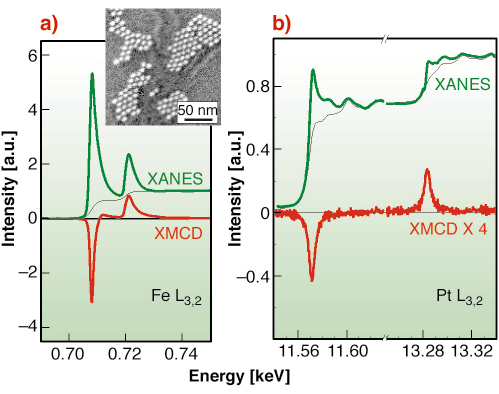- Home
- Users & Science
- Scientific Documentation
- ESRF Highlights
- ESRF Highlights 2005
- X-ray Absorption and Magnetic Scattering
- Plasma-assisted Magnetic Hardening of FePt Nanoparticles Investigated by X-ray Absorption
Plasma-assisted Magnetic Hardening of FePt Nanoparticles Investigated by X-ray Absorption
FexPt1-x nanoparticles are currently the subject of intense research activity due to their interesting magnetic properties [1]. Chemically-disordered Fe50Pt50 shows a high-temperature transformation to the ordered L10 phase which is associated with an enhancement of the orbital magnetic moment and a decrease of the mean distance between nearest-neighbour atoms by 2%. Therefore, on the one hand the X-ray absorption near edge structure (XANES) was analysed at the Pt L3,2 edges to monitor structural changes, and on the other hand the X-ray magnetic circular dichroism (XMCD) was measured both at the Fe and Pt L3,2 edges in order to investigate the orbital magnetism after thermal treatment.
The wet-chemically synthesised Fe50Pt50 particles with a mean diameter of 6 nm were self-assembled on a naturally oxidised Si substrate (total coverage: about 10%) and exposed to a soft hydrogen plasma (5 Pa for 30 min) that removes the Fe oxides and the organic ligands surrounding the particles in the as-prepared state (Figure 119). Subsequently one of the samples was annealed at 600°C in situ. Scanning electron microscopy (SEM) images confirm the mean size, the centre-to-centre distance of 9 nm and a small agglomeration after annealing.
 |
|
Fig. 119: Plasma chamber with ignited plasma. The inset shows schematically the removal of the organic ligands surrounding the wet-chemically synthesised FexPt1-x. |
For measurements at the Pt L3,2 edges, the UHV plasma chamber was attached to the experimental chamber at beamline ID12 and the Fe oxides were removed prior to the experiments. In order to be able to record high quality XANES and XMCD spectra at the Pt L3,2 edges on samples with such a low concentration of Pt, we have used a 35-channel silicon drift diode detector developed at the ID12 beamline in collaboration with Eurisys-Mesures (now Canberra Eurisys) [2]. During these experiments the counting rates in Pt L![]() lines were ca. 2·104 cps per channel with a peaking time of 0.5 µs. Even though the X-ray beam was impinging on the sample with an angle of incidence of ca. 15°, the beam footprint was quite small: 300 x 30 µm2. This is because we had to reduce the intensity of the monochromatic X-rays in order to avoid the saturation of the detector by the intense soft X-ray fluorescence signal from the substrates. The typical energy resolution of the emission spectra measured with one single SDD channel (data acquisition time: 60s; peaking time: 0.5 µs) was of the order of 132 eV for the unresolved Si K
lines were ca. 2·104 cps per channel with a peaking time of 0.5 µs. Even though the X-ray beam was impinging on the sample with an angle of incidence of ca. 15°, the beam footprint was quite small: 300 x 30 µm2. This is because we had to reduce the intensity of the monochromatic X-rays in order to avoid the saturation of the detector by the intense soft X-ray fluorescence signal from the substrates. The typical energy resolution of the emission spectra measured with one single SDD channel (data acquisition time: 60s; peaking time: 0.5 µs) was of the order of 132 eV for the unresolved Si K![]() ß , 159 eV for the Fe K
ß , 159 eV for the Fe K![]() line and 202 eV for the Pt L
line and 202 eV for the Pt L![]() 1 line. Excellent performances of this detector allowed us to record not only the XANES spectra, but also the XMCD signals at the Pt L3,2 edges in a weak magnetic field of ± 0.6 T (Figure 120b).The quality of the experimental data was high enough to derive the local spin and orbital magnetic moments of the Pt 5d states using the XMCD sum rules.
1 line. Excellent performances of this detector allowed us to record not only the XANES spectra, but also the XMCD signals at the Pt L3,2 edges in a weak magnetic field of ± 0.6 T (Figure 120b).The quality of the experimental data was high enough to derive the local spin and orbital magnetic moments of the Pt 5d states using the XMCD sum rules.
 |
|
Fig. 120: XANES (green lines) and XMCD (red lines) of pure metallic Fe50Pt50 nanoparticles measured at the Fe and Pt L3,2 edges. The dichroism spectra in (b) are scaled up by a factor of 4. The inset shows a SEM image of the sample. |
The results of this analysis together with the analysis of the spectra recorded at BESSY, Germany, on the same samples at the Fe L3,2 edges are given in Table 2.
 |
|
Table 2: Local spin and orbital magnetic moments for Fe and Pt. |
The observed trends in µl / µSeff indicate a non-cubic environment after annealing as expected for the L10 structure.
Additionally, we found that the period of the first EXAFS oscillations at the Pt L3,2 edges decreased by (2 ± 1)% after annealing indicating a reduction of the mean distance between the atoms as known for the disorder-order transformation in the corresponding bulk material.
In conclusion, we demonstrated a method to prepare pure metallic Fe50Pt50 nanoparticles from wet-chemically synthesised particles. Evidence for the formation of the L10 phase is provided both by structural changes found in the oscillations of the XANES and by the changes in the magnetic moments.
Acknowledgement:
This work was supported by the BMBF (05 ES3XBA/5), the DFG (SFB445), the EU (MRTN-CT-2004-005566, SyntOrbMag), and the ESRF.
References
[1] C. Antoniak, J. Lindner, and M. Farle, Europhys. Lett. 70, 205 (2005).
[2] J. Goulon, A. Rogalev, G. Goujon et. al., J. Synch. Rad. 12, 57 (2005).
Principal publication and Authors
C. Antoniak (a), J. Lindner (a), M. Spasova (a), D. Sudfeld (a), M. Acet (a), M. Farle (a), K. Fauth (b,c), U. Wiedwald (d), H.-G. Boyen (d), P. Ziemann (d), F. Wilhelm (e), A. Rogalev (e), and S. Sun (f), submitted.
(a) Fachbereich Physik, Universität Duisburg-Essen (Germany)
(b) MPI für Metallforschung, Stuttgart (Germany)
(c) Experimentelle Physik IV, Universität Würzburg (Germany)
(d) Abteilung Festkörperphysik, Universität Ulm (Germany)
(e) ESRF
(f) Department of Chemistry, Brown University, Providence, RI (USA)



